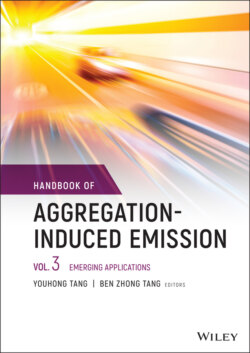Читать книгу Handbook of Aggregation-Induced Emission, Volume 3 - Группа авторов - Страница 21
1.3.1 Aggregation‐induced Phosphorescent Emissive Emitters
ОглавлениеThe phosphorescent OLEDs, as the second generation technique, can fully utilize both singlet and triplet excitons for 100% phosphorescent emission with the process of intersystem crossing from the lowest singlet excitons S1 to lowest triplet excitons T1 and further to the ground state S0, due to spin–orbital coupling effect usually caused by heavy metals. In 1998, Ma et al. [93] and Forrest et al. [94] first reported that heavy‐metal complex of osmium(II) or platinum(II) complexes can generate phosphorescence within OLED devices. In last few decades, the phosphorescent OLED developed quite rapidly with numerous phosphorescent emitters, including Ir(III) [95, 96], Au(III) [97], Pt(II) [98], Cu(I) [99, 100], and Os(II) [101] complexes merchandized, and even some pure organic compounds with room‐temperature phosphorescence [102, 103] and AIPE materials [104, 105] were reported.
This AIPE phenomena were discovered first by Lu et al. in the metal complexes of oxo‐bridged Re(I) AIPE 1–3 (Figure 1.6), with dim emission in pure acetonitrile solution, but a dramatic increase by adding water to this solvent [106]. Similar to AIE property, the AIPE phenomenon was also a result of the intramolecular motion restricted in mixed solvents. Till now, numerous AIPE compounds have been designed, but mainly applied in the areas of gas [107] or explosive detection [108], with limited applications in AIPE‐based OLEDs [109]. In 2011, Zhang, Zuo, and Zheng et al. designed the AIPE iridium complexes Ir(tfmppy)2(tpip) (Figure 1.6), and by doping it into the host of mCP, they prepared highly efficient OLED devices, exhibiting maximum luminance of 64 351 cd/m2 and a low efficiency roll‐off [110]. Likewise, He et al. took TPBI (Figure 1.6) and mCP as the bihosts for the AIPE emitter Ir(tfmppy) 2(tpip), with the ratio of TPBI : mCP : Ir(tfmppy) 2(tpip) at 1 : 1 : 1. The inverted PhOLED based on 0.5 nm doped EML experience significant and efficient roll‐off, with EQE from 31.1% at 100 cd/m2, to 24.2% at 1000 cd/m2, and finally to 17.0% at 10 000 cd/m2, as a result of TTA effect. By increasing the thickness of EML to 10.5 nm, the efficiency roll‐off of the PhOLED was sharply reduced, with EQE from 23.3% at 1000 cd/m2 to 19.2% at 10 000 cd/m2 [111]. AIPE emitters can also be applied in the nondoped OLED emitters. Su et al. utilized AIPE‐active iridium(III)‐based molecules to fabricate OLED through solution processing. The devices can reach the maximum CE of 25.7 cd/A, and EQE of 7.6% was achieved based on this AIPE‐active complex [109]. Recently, Wu et al. took advantage of Pt(II) metal complex DPA‐Pt (Figure 1.6) with simple structure as the emitter to prepare both nondoped and doped OLED devices. The doped ones with 6% weight content showed lower EQE of 9.2%, while the nondoped ones can reach EQE of 9.8% with deep‐red/NIR emission, showing facile fabrication and high performance of the nondoped device [112]. Therefore, it could be expected that increasingly more AIPE emitters could find applications in OLED, owing to their excellent solid‐state lightening performance.
Figure 1.6 Aggregation‐induced phosphorescent emitters.
